
10 PowerApps Alternatives & Competitors in 2025
Microsoft PowerApps was one of the first modern low-code platforms when it launched in 2015. The goal was to provide large businesses with a new, faster way to output custom applications.
Today, it’s used by developers and other IT professionals alike to simplify the process of building custom software.
Thousands of companies in all kinds of industries choose PowerApps for internal development projects.
However, that doesn’t mean that PowerApps is the right fit for every organization. As we’ll see, the low-code market is hugely varied - with different vendors targeting a range of use cases, developer personas, and market segments.
Today, we’re checking out some of the top PowerApps alternatives from across the market.
Specifically, we’ll cover the following:
The goal isn’t just to present a list of platforms. Rather, we want to give you a full account of where each of the key players sits in the market and how you can make an informed decision about which is right for your particular requirements.
Let’s jump right in.
Background
To frame our discussion, here are some of the key details you need to know about Microsoft’s internal application builder.
PowerApps is Microsoft’s low-code offering - within the wider Power Platform ecosystem. It’s based around building apps in a couple of different ways. PowerApps Studio is a visual builder, where creators with slightly lower levels of development skills can create interfaces on top of connected data using a drag-and-drop interface. Advanced users can build model-driven apps by defining a sitemap, creating server-side and client-side logic, and implementing more advanced integrations. As a Microsoft product, PowerApps skews heavily toward other platforms in their ecosystem. So, there’s close integration with the Dataverse, SQL Server, Power Automate, Dynamics, Sharepoint, and more. Therefore, it’s a particularly powerful solution for businesses that already have Microsoft platforms deeply embedded in their ops. PowerApps users fall into two camps. On the one hand, it’s a popular platform for citizen development programs. This involves upskilling specific business users within departments to output solutions for their colleagues. These people effectively become PowerApps specialists. Besides citizen development, PowerApps is also popular within IT teams. In particular, it’s deeply embedded in the way many large organizations build internal tools. So, professional developers can take advantage of a range of more advanced capabilities, including writing server-side functions using Azure, client-side functions in JavaScript, custom plug-ins, workflow extensions, and more. There are several reasons why you might be here today - whether you’re a current PowerApps user or you’re assessing low-code development platforms for the first time. The reality is that there are several challenges of using PowerApps which have the potential to make it unviable for many use cases. One issue is that it has a particularly steep learning curve compared to other platforms in this sector. It can be comparatively difficult for a user - technical or not - to simply jump in and start building working tools. Besides this, it’s important to be cognizant that PowerApps is heavily embedded in the wider Microsoft ecosystem. This means that developer experiences tend to prioritize working with native platforms. On the flip side, this can mean that handling external data is somewhat more convoluted than in some of PowerApps’ competitors. This largely requires us to go through the Dataverse or Dynamics 365 in order to pull data into PowerApps projects. Similarly, the full complement of functionality can only be achieved through the use of the wider Power Platform ecosystem. For example, using PowerApps to build interfaces but relying on Power Automate for automating internal processes. Finally, PowerApps is entirely closed-source. In many organizations, this can be a deal breaker for any platform that’s going to have access to sensitive data. Similarly, it can’t be self-hosted. Or, much more simply - PowerApps may be a viable option for you - but you may find a more cost-effective way to meet the same objectives. Check out our guide comparing Pega vs AppianWhat is PowerApps?
Who uses PowerApps?
Why would you need a PowerApps alternative?
10 PowerApps alternatives
Now that we’ve seen what PowerApps is and where it sits in the market, we can start to run through some of its key competitors.
The low-code market is fairly varied in terms of the users that specific vendors target. This ranges from platforms for empowering everyday users to build solutions on one end of the spectrum - to full-blown developer tools at the other.
We’ve selected tools from various points along this spectrum.
These are:
 PowerApps |  Budibase |  Retool |  Mendix |  Outsystems |  Appian |  AppSheet |  Quickbase |  Zoho Creator |  Filemaker |  Airtable | |
|---|---|---|---|---|---|---|---|---|---|---|---|
| Pricing Model | Per user | Per creator + per user | Per creator + per user | Flat fee + per user | Custom | Per user + usage-based | Per user | Per user | Per user | Per user | Per user |
| Built-In Database | |||||||||||
| RBAC | |||||||||||
| Custom Components | |||||||||||
| Automation Builder | Via Power Automate | ||||||||||
| SSO | Paid | Free | Paid | Paid | Paid | Paid | Paid | Paid | Paid | Paid | Paid |
| Security certs | ISO27001SOC 2 | ISO27001 | SOC 2 | ISO27001SOC 2 | ISO27001SOC 2 | ISO27001SOC 2 | ISO27001SOC 2 | ISO27001SOC 2 | ISO27001SOC 2 | ISO27001SOC 2 | ISO27001SOC 2 |
| Audit Logs | |||||||||||
| App Embeds |
Let’s take each one in turn.
1. Budibase
Budibase is the open-source, low-code platform that empowers teams to turn data into action.
Connect any data, build professional interfaces, automate manual processes, and host your tools wherever you like - with minimal custom coding.
Budibase is the ideal solution for busy IT teams that need to output internal tools at pace. Systems architects, data professionals, product owners, and all kinds of other IT roles choose our platform to ship incredible solutions - without burdening internal development teams.

Features
Budibase offers leading connectivity for external data sources. Build applications based on SQL and NoSQL databases, REST APIs, Google Sheets, or our internal database. You can even build your own custom data source plug-ins with our dedicated CLI. Easily create advanced views on top of connected data to control user access in conjunction with our fully customizable visual RBAC editor.
It’s never been easier to build stunning user interfaces without writing extensive custom code. Autogenerate CRUD screens and forms, customize your app styling, and configure a huge range of native components to empower your team to interact with your data.
Budibase also empowers teams to automate menial admin tasks with a huge range of configurable, nestable actions that can be triggered by external events, with in-app actions, or as scheduled jobs. Budibase automations offer branching and looping logic, as well as a range of AI operations, using OpenAI, Azure, or Budibase AI.
You have the complete power and flexibility to host your Budibase applications how and where you want. Choose Budibase Cloud - or self-host with Kubernetes, Docker, Digital Ocean, Portainer, Podman, and more.
We’re also proud to offer some of the most generous pricing in the low-code space, with free SSO, granular RBAC, multiplayer collaboration, and unlimited applications across all plans.
Use cases
Budibase is the ideal vehicle for building all kinds of internal tools. You can easily output CRUD apps, approval tools, dashboards, portals, forms, and any other data-centric UIs in a fraction of the time a traditional build might take.
The reality is that internal development teams don’t have the time or resources to meet the demand for digital solutions.
So, IT departments need a faster, more cost-effective way to ship applications for internal users.
Budibase empowers non-developers in technical teams to leverage data and build custom solutions for managing all kinds of workflows - without requiring extensive custom coding skills.
Check out our features overview to learn more.
Pricing
Budibase offers three distinct pricing tiers to scale as your needs grow and evolve - Free, Premium, and Enterprise. On the free tier, you can build unlimited applications for up to five users in the cloud or twenty users if you self-host - with free SSO.
Premium licenses are billed based on usage. We distinguish between users who build applications and those who use them. Creators are billed at $50 per month while end-users are $5.
Premium users also have access to custom branding, synchronous automations, and other advanced capabilities.
Enterprise licenses offer custom pricing, with enforceable SSO, environment variables, user groups, audit logging, air-gapped deployments, priority support, and much more.
2. Mendix
Mendix is another one of the more established names in the low-code space. It’s also one of the most developer-centric platforms on our list - aimed firmly at expediting projects for traditional development teams.
More specifically, Mendix is squarely aimed at the enterprise market. For example, it offers dedicated functionality for integrating into the SCRUM lifecycle.
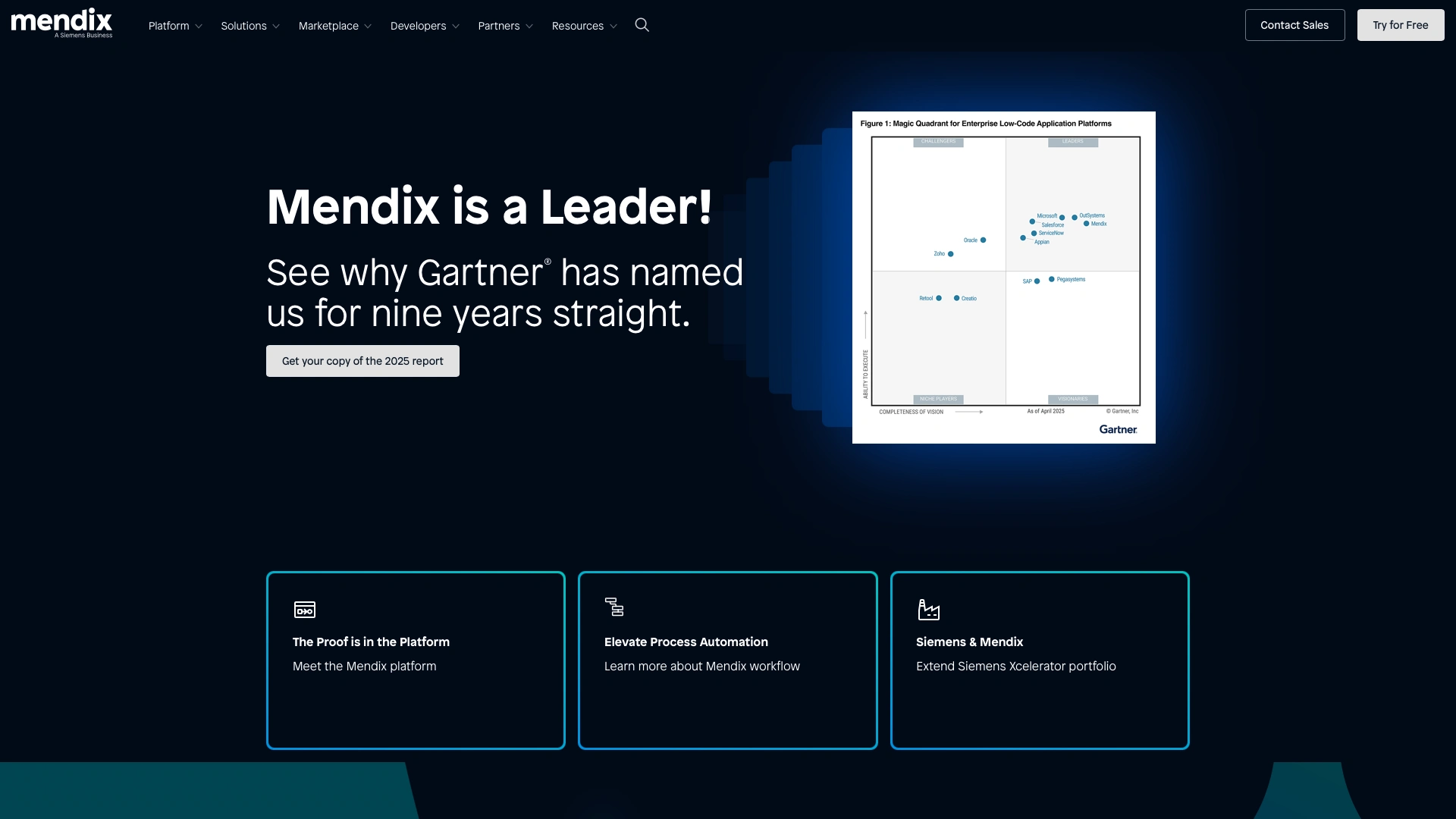 (Mendix Website)
(Mendix Website)
Pros
Mendix’s centerpiece is its visual IDE - Mendix Studio Pro. This offers a sleek, intuitive drag-and-drop experience for building interfaces - along with support for custom front-end scripting, advanced version control, and other highly developer-centric functionality.
Mendix also outshines many other PowerApps alternatives on extensibility. It offers a dedicated SDK for building custom extensions, integrations, and other tools - making it a strong choice for legacy modernization and other more complex low-code use cases.
It also benefits from a large, active community of users, providing huge swathes of resources, tips, and extensions that can be used by other Mendix developers.
Cons
Like PowerApps, Mendix sits somewhat toward the more code-intensive side of the low-code market. This affords a certain degree of extra flexibility, but it also means that its viability may be comparatively limited for users with lesser development skills.
For example, there isn’t much native customization on offer when it comes to building user interfaces. In fact, we may have to rely on custom CSS for design tasks that can be handled visually in other platforms.
Some users also complain that Mendix applications can suffer from performance issues at scale. However, this is often resolvable with appropriate optimization strategies. For instance, implementing batching when comitting large volumes of data.
Pricing
Compared to some other PowerApps alternatives, Mendix can be relatively expensive. There are three pricing tiers that allow us to build a single application - free, standard, and premium. Premium is the custom option for enterprises.
Standard bills at $998 per month. However, it’s important to note that this doesn’t include the required hosting and compute resources, which will be billed separately.
If you want to build for than one application in Mendix, the cheapest paid option is the standard tier at $2495 per month, plus each additional user.
3. Retool
Retool is another highly developer-focused low-code platform. Ultimately, its goal is to enable development teams to expedite projects - freeing them up to focus on their core product instead of building internal tools.
Launched in 2017, it’s a slightly newer entrant to the space than either Mendix or PowerApps, but it has nonetheless cornered a significant portion of the internal tools market. More recently, it’s also launched a suite of tools for building LLM-powered systems, including AI agents.
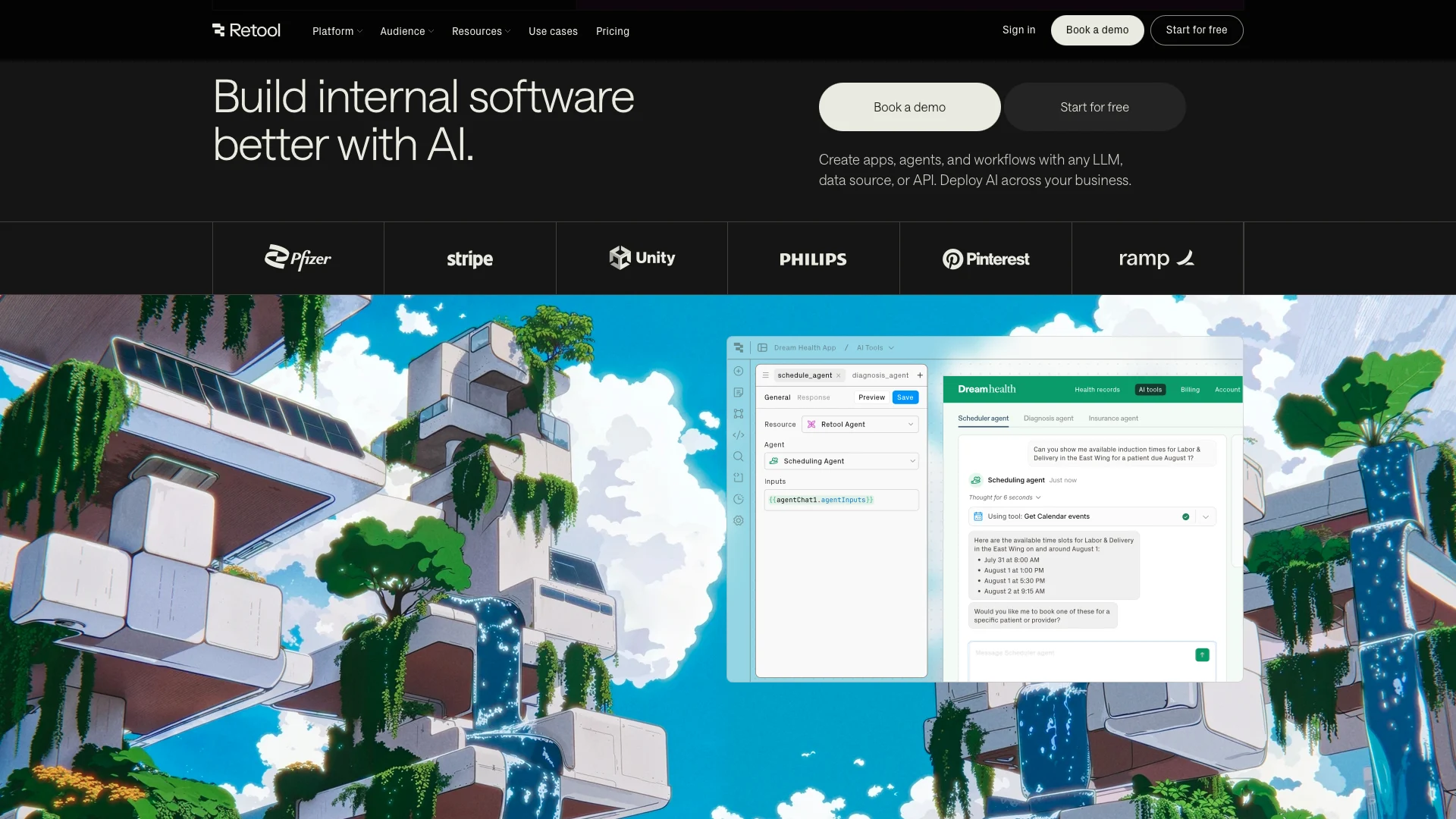 (Retool Website)
(Retool Website)
Pros
One of the reasons for Retool’s popularity is that it was one of the first platforms to bring more modern user experiences to a low-code platform. It offers a powerful, intuitive interface for combining and configuring UI elements.
It also offers extensive flexibility when it comes to connecting to external data sources. Retool offers a considerable number of native connectors. Unlike PowerApps, we don’t need to go through additional platforms to configure these.
Retool is also a particularly strong offering for workflow automation. The automation builder is built around a user-friendly flow-based interface, with huge scope for custom code, branching logic, and more - creating the potential for very powerful solutions. It also offers intuitive experiences for building, managing, and deploying AI agents, capable of calling external tools.
Cons
Of course, Retool has downsides too. Like Mendix, it’s relatively expensive compared to some other low-code tools. This can present barriers to getting up and running for many organizations who want to experiment with low-code.
It also has quite a high requirement in terms of technical skills. So, compared to some other more no-code platforms in this list, you may need to write custom code more often to achieve specific functionality.
Retool has also suffered reputational problems after a large-scale data breach in August 2023 due to a phishing attack, although the platform itself offers extensive enterprise-grade security capabilities.
Pricing
Retool offers four pricing tiers - Free, Team, Business, and Enterprise. Like Budibase, it distinguishes between end users and app creators in its pricing. In terms of per-user costs, it’s not excessive. The free tier can be used with up to five users in the cloud or self-hosted.
However, there are limitations at each price point that could inhibit scalability. For example, the Team tier charges $10 per month for creators and $5 for end users. But, it also imposes a limit of 5,000 automation runs per month. We’ll need a Business license at $50/$15 per month to access embedded apps or custom branding.
Features like SSO, platform APIs, and custom branding are restricted to custom pricing. If you need these, Retool could be a particularly pricey option.
Take a look at our guide to the top Retool alternatives .
4. Appian
Appian sits at a different point in the low-code market. The difference is that it aims more at everyday business users than technical colleagues like IT teams or developers - as most of our PowerApps alternatives have so far.
Therefore, its messaging is more focused on process management - especially leveraging AI - than app development. Of course, in practice, this means much of the same functionality is on offer.
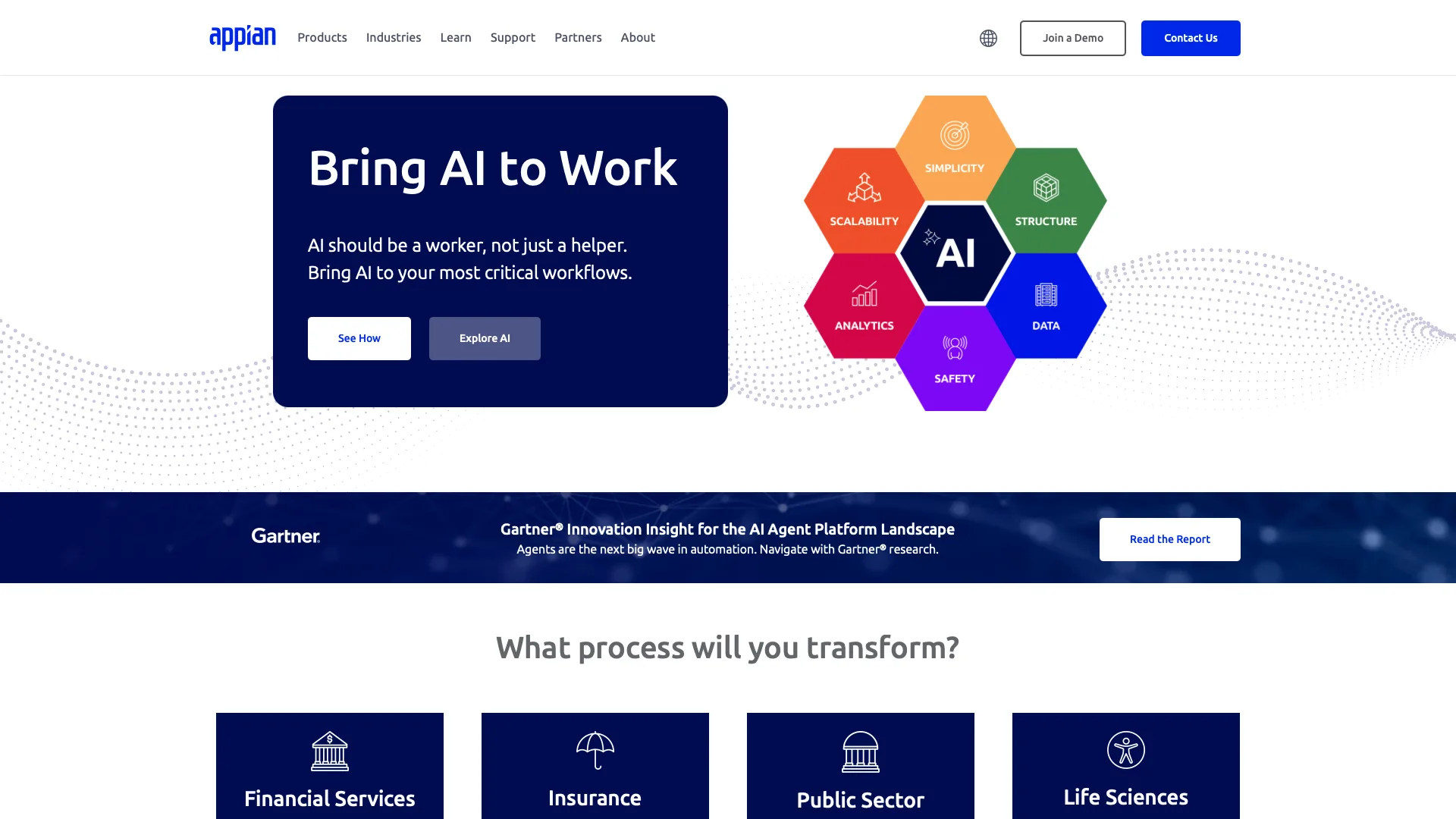 (Appian Website)
(Appian Website)
Pros
Appian is another low-code tool, but it skews more heavily toward process management and automation than some of the other platforms we’ve seen. So, we get native AI tools, robotic process automation, process discovery, and more.
Appian is a great fit for teams that want to automate processes securely. There are specific governance tools, so IT teams can retain control. It’s also impressive when it comes to implementing security controls over AI-based solutions.
Finally, Appian offers a suite of features aimed at helping you to analyze and define how tasks ought to be completed - including advanced analytics, monitoring, and process mining capabilities.
Cons
Some users complain that Appian some of the flexibility in key aspects that we might see in other platforms, including when it comes to designing UIs for internal tools.
According to some reports, it can also have a comparatively steep learning curve.
Some users also complain that Appian isn’t ideal for working with data on a larger scale. There are reports of performance issues with large data sets.
Pricing
Appian’s pricing is based around three tiers, on a per-user per-month model - Standard, Advanced, and Premium.
However, the specific costs associated with each of these are not currently available on their pricing page.
Each tier implements distinct feature and usage restrictions. For example, we’ll need an Advanced license to access most AI capabilities.
5. AppSheet
AppSheet is another departure from some of the other PowerApps competitors we’ve seen. It’s really more of a no-code tool, whereas the other platforms in this round-up are low-code solutions.
On the one hand, this means it can be used by a far wider set of users. On the other, it means that customization and more advanced use cases are significantly limited.
 (AppSheet Website)
(AppSheet Website)
Pros
AppSheet makes it incredibly easy for users without much in the way of technical skills to build working applications - albeit, relatively simple ones. For example, creating simple data entry forms, CRUD apps, or approval tools on top of a spreadsheet.
Business logic can be implemented using a range of AI or visual tools - or familiar spreadsheet formulae.
On top of this, AppSheet offers a few deployment options. We can publish instantly in a flow that’s similar to the wider WorkSpace ecosystem. Or, we can deploy to native mobile app stores with relative ease.
Cons
Again, the downside to this is that opening up the platform to a wider set of creators sacrifices a certain amount of power and flexibility. There’s really no scope for custom code, other than using Google App Scripts. AppSheet also can’t be self-hosted.
Like PowerApps, AppSheet also skews heavily toward the vendor’s native ecosystem. It’s easy to build applications with Google Sheets or external SaaS tools as data sources, but connecting to external databases can be a bit more awkward - although not impossible.
Different pricing tiers also impose limits in terms of the attached spreadsheets.
Pricing
Like most PowerApps alternatives, AppSheet is billed on a per-user basis. However, there’s no distinction between end-users and developers. Everyone is charged the same. You can have up to ten users with a free license.
The Starter and Core tiers charge $5 and $10 per user per month, respectively. However, these still limit you to spreadsheets as data sources.
You’ll need to purchase an enterprise license with custom pricing in order to use SaaS tools, APIs, or external databases within your application’s data layer.
6. OutSystems
Next, we have OutSystems - another veteran platform in the low-code market. Out of all of our PowerApps alternatives, this is perhaps the most explicitly developer-focused.
It’s also one of the most enterprise-centric platforms in the low-code market. So, it also comes with a suite of tools around testing, performance monitoring, and other pieces of functionality aimed at more complex development processes.
 (OutSystems Website)
(OutSystems Website)
Pros
OutSystems provides some of the most advanced developer experiences of any tool in its class. For example, it is a particularly strong offering in terms of multi-platform development - including web apps, native mobile apps, PWAs, and more.
Besides this, customization options are extensive. Developers can build their own custom integrations, components, and code modules. The Forge Marketplace is a vast resource of community contributions.
OutSystems also provides advanced capabilities around generative AI. This is helpful for developers creating, testing, and monitoring code, as well as as building AI agents.
Cons
OutSystems is not one of the most user-friendly PowerApps alternatives. Like many developer tools, it can be quite tricky to get up and running. For instance, other self-hostable Retool alternatives can be easier to set up.
This is particularly challenging, as the cloud-based version of the platform imposes additional limitations - including around data support.
On top of this, OutSystems presents a very steep learning curve for new users. Since it’s a more complex solution in the first place, it’s important to get familiar with its particular architecture and development style before you can ship solutions.
Pricing
OutSystems pricing is somewhat different to many of the other PowerApps alternatives we’ve seen so far. This is based around a proprietary concept known as Application Objects (AOs). An AO can be any aspect of how we build an application, including databases, tables, screens, API requests, and more.
Licenses for OutSystems Developer Cloud start from $36,300 for a single application with up to 100 internal users. We’ll then need to pay additional fees for extra users, building multiple apps, or 24/7 support.
Self-hosting is billed as an advanced add-on.
7. Quickbase
Quickbase is one of many platforms that aim to help businesses use their data more effectively. Its purpose is to first centralize and de-silo data - and then enable teams to build internal tools and processes around this.
Compared to some of our other Power Apps alternatives, Quickbase is aimed at users with a somewhat lower technical skill level. The goal is largely empowering non-IT colleagues to build solutions while allowing IT teams to retain governance and control.
 (Quickbase Website)
(Quickbase Website)
Pros
One of Quickbase’s major selling points is the ease with which non-technical colleagues can output working tools - especially for simple tools like forms, dashboards, and reports. This is aided by an intuitive, flexible WYSIWYG editor for building UIs.
Quickbase also provides extensive functionality aimed at larger teams. For example, it offers tools for enabling IT teams to govern access to internal data assets, including RBAC, admin functionalities, custom governance policies, and more.
In terms of specific use cases, Quickbase is a particularly strong offering for basic data-centric solutions like reporting and dashboards. However, it also offers a visual automation builder, so it can be an effective tool for handling internal processes and workflows too.
Cons
While Quickbase is largely aimed at non-technical colleagues, many users complain that experiences for relatively common tasks are overly complicated. For instance, while it’s possible to query external data sources, configuring this is difficult compared to some competitors.
On the flip side, Quickbase’s UI builder is highly opinionated. This makes it easy to build certain kinds of tools, but can also limit the degree of flexibility and customization on offer - with many users complaining this is insufficient for their requirements, outside of the platform’s core use cases.
Another common complaint is that Quickbase is relatively expensive compared to other tools in its class. It’s also fully closed-source and lacks support for self-hosting, so can be ruled out if either of these are firm requirements.
Pricing
Quickbase is one of the few Retool alternatives we’ve seen today that doesn’t offer a fully free tier. Rather, there’s a 30-day free trial. Besides this, the cheapest price point is the Team tier, which bills at $35 per user per month.
The Business tier bills at $55 per user. This will unlock key security features like SSO and SCIM provisioning, as well as additional UI tools, including interactive Gantt charts.
We can also opt for custom enterprise pricing to access additional security features and enhanced audit logging.
8. Zoho Creator
Next, we have Creator, Zoho’s low-code offering. This occupies a slightly different corner of the app-building market than platforms like Power Apps. It’s squarely aimed at the citizen development market.
So, it’s strongest in terms of providing IT teams with a platform to empower their on-the-ground colleagues to output solutions for their own needs in a controlled manner - without undermining existing governance policies.
 (Zoho Creator Website)
(Zoho Creator Website)
Pros
As part of the wider Zoho ecosystem, Creator is relatively strong on external data support - in particular around other SaaS platforms. Users can easily access and manipulate data from a wide range of CRMs, ERPs, and other platforms, using native integrations. Like many other PowerApps alternatives, it’s also launched a range of AI capabilities in recent years.
Creator is also an attractive offering when it comes to governance. We can combine flexible RBAC with custom security policies to create very granular rules for how users interact with our data assets.
Notably, Creator offers funcitonality for outputting working apps from natural language prompts, as well as capabilities for shipping native iOS and Android apps.
Cons
Some users complain that it offers more limited customization thatn some other platforms in this space, so it may be less suitable for professional developers working on more advanced use cases.
In many ways, Creator is generally optimized for IT teams and on-the-ground users working in tandem to create solutions. Therefore, it might be less suitable for other kinds of low-code developments where these cohorts are working in isolation.
Although it’s generally fairly affordable as we’ll see in a second, Zoho doesn’t offer a fully-featured free version of Creator, only a 15-day free trial.
Pricing
Creator’s pricing is based on three fixed monthly per-user tiers - Standard, Professional, and Enterprise, as well as the option for custom pricing. It has the potential to be a relatively cost-effective option, although we’re limited to a single application on the Standard tier.
Pricing is also a little bit less predictable than some other vendors in the low-code space. There are additional usage-based limits based on both automation runs and connected data, so we might need to upgrade to a premium tier as a result of these.
Novelly, certain enterprise features like SSO are available on all tiers but billed as an optional extra for Standard and Professional licenses.
9. Filemaker
FileMaker is one of the oldest names in the low-code space. In fact, it’s been around since the 1980s. On the one hand, this makes it a stable, relatable solution for building certain kinds of internal tools.
In recent years, though, it’s reinvented itself as a powerful platform for implementing AI capabilities within application projects.
 (Filemaker Website)
(Filemaker Website)
Pros
In 2025, Filemaker is largely aimed at empowering teams to build low-code applications, with AI capabilities, including semantic search, retrieval, and document summarisation. This can be powered by OpenAI or locally hosted, open-source models.
The wider Filemaker platform centered around a drag-and-drop interface for creating database schemas - without the need to manually write queries. We can also build simple interfaces like Forms - or even create automations for basic database management tasks.
Filemaker provides dedicated functionality for shipping native web and mobile applications - making it an effective solution for teams that need to develop cross-platform tools without necessarily having extensive technical skills.
Cons
Some users note that aspects of Filemaker’s UI and UX can feel a little bit dated compared to some other platforms.
For building basic applications and data models, users also report that there can be a relatively steep learning curve.
Some other platforms are also stronger on external data support, whereas in Filemaker connecting to certain types of data largely relies on API requests or ODBC, rather than offering native connectors.
Pricing
Filemaker offers two fixed pricing tiers for the cloud product. For $22 per user per month, the Starter tier offers three applications for between five and ten users.
The Max tier ($45) expands these limits to 256 applications for up to 99 users. For 100 or more users, we’ll need to opt for custom enterprise pricing. Self-hosted Filemaker Server licenses start at $17.50 for up to 99 users.
There are also usage limits across all pricing tiers relating to things like data storage, API requests, and computing resources.
Take a look at our round-up of the top Filemaker alternatives .
10. Airtable
Lastly, we have Airtable. Again, this occupies a slightly different corner of the market than Power Apps, but as one of the most popular options for creating custom solutions quickly, it’s an important platform to be familiar with.
Its niche is empowering teams to take advantage of much of the power and flexibility of traditional database tools - with a familiar, spreadsheet-like experience. On top of that, there’s extensive functionality for building interfaces and automating workflows.
 (Airtable Website)
(Airtable Website)
Pros
Airtable’s popularity largely comes down to how easily users can create advanced data management solutions - both in terms of storage and facilitating user interactions. It offers spreadsheet-like interactions, where users can interact with data in much the same way they would in Excel or Google Sheets.
More importantly, as a Power Apps alternative, Airtable offers functionality for building custom interfaces on top of stored data - in particular, reports, forms, tabular UIs, and dashboards. Like Zoho, Airtable also offers experiences for creating working solutions from natural language prompts. There’s also capabilities for building agents, alongside Omni, Airtable’s built-in AI assistant.
Like Power Apps, Airtable offers an impressive number of pre-built interface and data model templates, making it easy to get up and running with the platform for a broad range of use cases.
Cons
The real downside to Airtable is that it’s largely focused on getting businesses to migrate their data ops in their entirety. So, there’s relatively little support for external data sources - except for Saas integrations and API requests.
We can’t, for example, natively query SQL databases directly and use their responses to populate Airtable front-ends. Rather, we’d need to import a dump of our database into SQL or configure API requests manually to achieve similar functionality, or rely on third-party tools.
Airtable is also an exclusively cloud-based platform. So, if self-hosting your internal tools or data assets is a firm requirement, you’ll need to look elsewhere.
Pricing
Airtable is primarily billed on a per-user basis, but there are also usage limits in terms of stored data and automation runs. The free tier offers up to 1,000 rows per base for up to five users, with 500 monthly AI credits.
The Team and Business tiers bill at $20 and $45 per user per month, respectively. However, Airtable doesn’t distinguish between end users and creators, meaning that it has the potential to be very expensive to scale solutions.
Additionally, custom pricing is required to store more than 500,000 rows per base, to make more than 500,000 automation runs in a month, or to access premium security features.
PowerApps vs Budibase
Now that we’ve seen a range of different platforms from across the no/low-code market, it’s time to dive deeper into how PowerApps and Budibase stack up together.
Both platforms set out to solve a similar problem. Businesses need faster, more cost-effective ways to output internal tools.
However, within this, they differ in terms of the more granular approach they take to this. PowerApps targets a wider user base - from professional engineers to designated citizen developers within departments.
At Budibase, we’ve tailored our product for colleagues within IT teams who need to furnish their colleagues with professional data-centric apps - whether these are solutions engineers, product managers, data specialists, or other technical roles.
Data
When it comes to supported data, PowerApps heavily favors the wider Microsoft ecosystem. So, it’s easy to interact with SQL Server, Dynamics, SharePoint, or data stored in other native platforms.
Budibase takes a very different approach. We offer a huge range of native data connectors, including MySQL, Postgres, MSSQL, Couch, REST APIs, S3, Oracle, Mongo, Google Sheets, and many more.
You can even build your own custom data source plug-ins with our dedicated CLI - or use BudibaseDB to create a data model from scratch without writing a single query.
UIs
PowerApps is well-known for presenting a steep learning curve when building app UIs. Some simple tasks like adding form logic or in-app navigation may require us to manually write formulae using Power Fx - a proprietary language based on visual basic.
With Budibase, coding is very much optional.
Our UI builder is focused on offering advanced capabilities within an easy-to-use drag-and-drop platform. So, you can simply drag in components and populate them with connected data, but we also offer native mobile responsiveness and custom conditionality. You can even autogenerate CRUD and form UIs based on connected tables or views. Autogenerated screen inherit the access rules of the underlying data, making it easier than ever to ship secure internal tools at pace.
Budibase also offers front-end scripting using JavaScript or a huge library of handlebar helpers. Whether you’re a seasoned developer or a less technical user, Budibase makes it easy to implement custom logic on top of professional designs.
Automations
PowerApps is sometimes used for automating manual tasks, but many use cases will require us to use Power Automate - which is a separate platform under the Power Platform umbrella.
By contrast, Budibase has a powerful built-in automation editor. We offer a large set of configurable automation actions, which can be triggered as scheduled jobs or using in-app actions, database events, or incoming API requests and WebHooks.
It’s never been easier to build custom automations to manage internal processes, data, and workflows.
Functionality
Budibase is also the clear leader in terms of enterprise functionality. We offer free SSO for all users, optional self-hosting, a built-in database, custom data source plug-ins, and much more. We also offer a range of advanced AI features, which can be powered by OpenAI, Azure, or Budibase AI.
You can even build as many applications as you want on our free tier, with pricing plans that scale as your needs grow and change.
So, as well as making it considerably easier to build custom applications with a wider range of data sources, Budibase is also much better positioned to meet the needs of modern, agile, and security-first businesses.
How to choose a PowerApps alternative
We’ve seen a variety of PowerApps competitors today that occupy very different corners of the low-code market. Of course, we need to be realistic that no single tool can be the right fit for every organization or use case.
So, it’s important to outline the specific decision points that you’ll encounter when assessing the market to find the right platform for your needs.
Pricing
Perhaps the most obvious variable that we’ll need to consider is the relative costs of our different options. This is slightly trickier than you might initially think. For one thing, each of the vendors we’ve seen so far structures their pricing plan differently.
So, some are per-user, some are per-user and per-creator, and some are per-app - or a combination of these.
Within this, each platform also takes a different approach to imposing other usage limits across their respective pricing tiers - whether these are based on automation runs, connected data, feature restrictions, or some other variable.
User personas
Next, we need to choose a platform that’s appropriate for the kinds of colleagues we envision using it. As we’ve seen, there’s quite a broad scope here - from tools for non-technical business users, all the way up to full-on development tools.
Obviously, there’s a fair amount of grey area here. Broadly speaking though, here’s how the market breaks up in terms of target users:
 PowerApps |  Budibase |  Retool |  Mendix |  Outsystems |  Appian |  AppSheet |  Quickbase |  Zoho Creator |  Filemaker |  Airtable | |
|---|---|---|---|---|---|---|---|---|---|---|---|
| Technical level - Target users | High - Engineers | Medium - IT teams | High - Engineers | High - Engineers | Medium - IT teams | Medium - IT teams | Low - Business users | Low - Business users | Medium - IT teams | Medium - IT teams | Low - Business users |
Open-source / Souce-available vs closed-source
For some organizations - particularly enterprises, public bodies, and other security conscious businesses - open-source technology is a massive priority. The ability to audit the source code of software that interacts with mission-critical data is crucial.
Here are the tools we’ve seen today, broken down by open vs closed source code:
 PowerApps |  Budibase |  Retool |  Mendix |  Outsystems |  Appian |  AppSheet |  Quickbase |  Zoho Creator |  Filemaker |  Airtable | |
|---|---|---|---|---|---|---|---|---|---|---|---|
| Open-source vs Closed-source | Closed-source | Open-source | Closed-source | Closed-source | Closed-source | Closed-source | Closed-source | Closed-source | Closed-source | Closed-source | Closed-source |
Extensibility
Extensibility is how much scope a particular platform affords us to add our own functionality, integrations, UI elements, or other features. This can be critical, particularly in niche use cases or situations where we’re dealing with esoteric data.
It can also simply be helpful to have the ability to extend a given platform to add functionality that the vendor doesn’t natively provide.